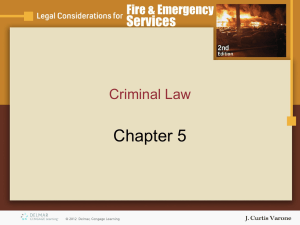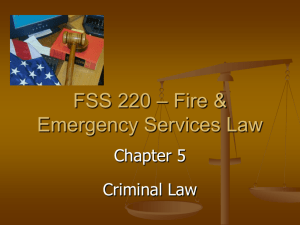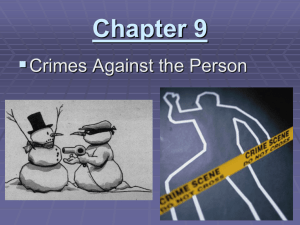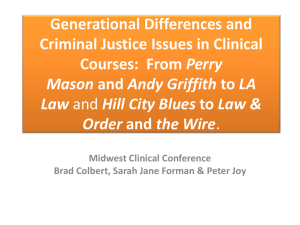Criminal Law
advertisement
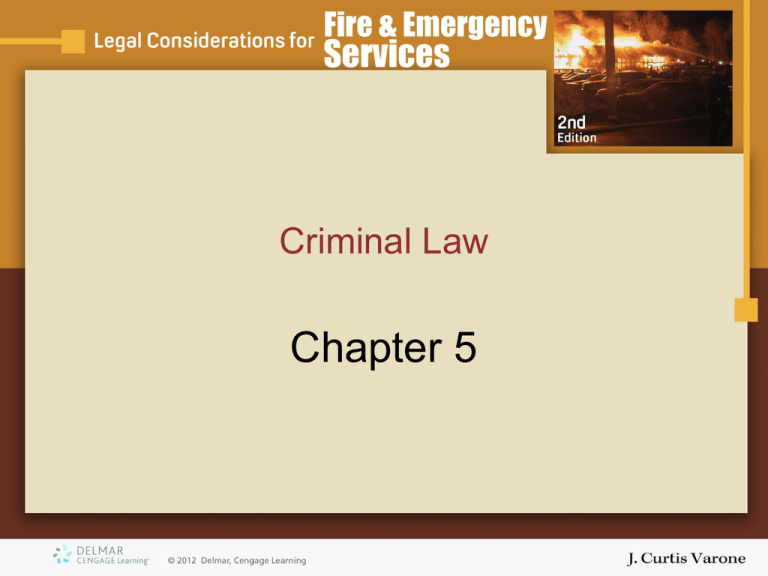
Criminal Law Chapter 5 Objectives • Distinguish between violations of civil and criminal law, and between felonies and misdemeanors. • Identify three elements making up a crime. • Explain when an omission can give rise to criminal liability. • Identify the four criminal mental states. Objectives • Identify elements for the following crimes: – First-degree murder, second-degree murder, voluntary manslaughter, involuntary manslaughter, battery, assault, sexual assault, rape, and child molestation Objectives • Identify elements for the following crimes: – Larceny, robbery, obtaining money under false pretenses, extortion, embezzlement, burglary, false imprisonment, kidnapping, RICO – Arson Criminal versus Civil Law Criminal Law Civil Law Brought by Government Party who has been wronged Burden of Proof Beyond a reasonable doubt More likely than not Penalty Jail, probation, fine or restitution Money damages or a court order Definition of Crime • Criminal conduct – Common law crimes – Statutory crimes • Violation of a law is not criminal unless the law declares that it is criminal Reasons for Criminal Punishment • Deterrence • Protect society from wrong-doer through incarceration • Vindication of victim and society – Satisfies need for justice Felonies and Misdemeanors • Felonies are more serious offenses – Punishable by more than one year in jail • Misdemeanors are less serious – Punishable by one year or less in jail Elements • Defined by statutes and/or case law • Crime is made up of elements – Act – Mental state – Attendant circumstances Act • The act requirement can be satisfied by either an affirmative act or an omission – Act or omission must be a voluntary act – An involuntary act cannot be basis for criminal liability Mental State • Four criminal mental states (Model Penal Code) – Purposeful – Knowing – Reckless – Negligent Strict Liability • Most crimes require proof of a culpable mental state – Model Penal Code definitions • Some relatively minor crimes do not – Referred to as strict liability crimes – Common with regard to regulatory offenses Attendant Circumstances • Other fact must exist • Additional facts that must be proven • Example – Convicted of assault on a uniformed officer • Officer must be in uniform Homicide • Includes two basic crimes – Murder – Manslaughter Murder • Killing with malice aforethought – Act: Killing or causing death – Mental state: Malice aforethought • Purposeful • Knowing • Recklessness indicating depraved heart Murder • First-degree murder – Premeditated murder – Unintended death of someone during the commission of a felony (felony murder) • Second-degree murder – Any murder not first degree Manslaughter • Voluntary manslaughter – Intentional killing in the heat of passion as a result of severe provocation • Involuntary manslaughter – Unintentional killing Battery • Unpermitted offensive touching of another • A person can consent to being touched – Thus consent is a defense to battery charges – Consent must be knowing and voluntary – Consent may be implied Battery and Emergency Responders • Medical treatment involves touching • Consent implied from the circumstances – Person calls for rescue/EMS assistance – Person does not object to treatment • Consent may be withdrawn or limited Battery and Consent • Consent induced by fraud, deceit, or misrepresentations is not valid – Example: Person pretends to be a doctor and is allowed to examine and treat a person • Implied consent is limited by circumstances Assault • Placing another in immediate physical harm • Some jurisdictions say it is an attempted battery that is unsuccessful • Consent rules apply to assault False Imprisonment • Unlawful restraint upon a person’s freedom and ability to come and go • Also called false arrest – Some authorities say false arrest is one type of false imprisonment Kidnapping • Use of force (or threat of force) in taking someone from one place to another • Modern statutes – Forcibly or secretly confining someone against their will – Forcibly carrying or sending someone out of the state Rape • Common law – Sexual intercourse without other’s consent • Modern trend – Expanded definition of sexual assault via degrees – First-degree sexual assault – Second-degree, etc. Larceny • Common law – Taking and transporting of property with intent to permanently deprive • From common law crime of larceny – Now a broad range of theft crimes Robbery • Larceny through use of force or threatened use of force • Taking money or other personal property – By means of force or use of fear Extortion • Obtaining money or property – Requiring someone to do something they are not legally required to do • Threats necessary for extortion – Bodily injury, damage to property – Revealing information about the victim Burglary • Most states have statutory offenses to address loopholes in common law – Breaking and entering (B&E) • Of dwelling (to cover daytime breaks) • Of other buildings • Of dwelling while possessing instruments related to wrongful setting of fires Arson • Common law definition – Willful and malicious burning of the dwelling of another • Common law crime had many loopholes • All states now have comprehensive arson laws RICO • Racketeer Influenced and Corrupt Organizations Act – Illegal for a person to engage in a racketeering activity through the use of an organization – Both civil and criminal aspects Summary • • • • Criminal law Three types of elements Criminal mental states Criminal offenses
